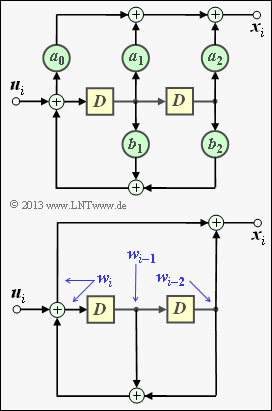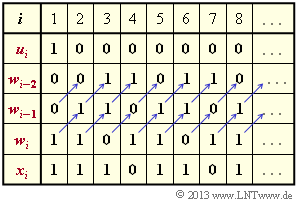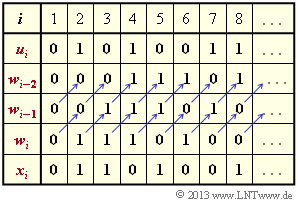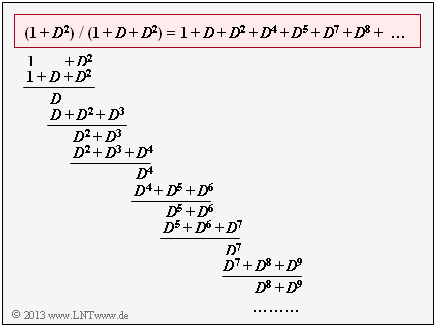Aufgabe 3.5: Rekursive Filter für GF(2)
Die obere der beiden dargestellten Schaltungen zeigt ein rekursives Filter zweiter Ordnung in allgemeiner Form. Mit
- $$A(D) \hspace{-0.15cm} \ = \ \hspace{-0.15cm} a_0 + a_1 \cdot D + a_2 \cdot D^2 \hspace{0.05cm},$$
- $$B(D) \hspace{-0.15cm} \ = \ \hspace{-0.15cm} 1 + b_1 \cdot D + b_2 \cdot D^2 $$
erhält man für die Übertragungsfunktion
- $$G(D) = \frac{A(D)}{B(D)} = \frac{a_0 + a_1 \cdot D + a_2 \cdot D^2}{1 + b_1 \cdot D + b_2 \cdot D^2} \hspace{0.05cm}.$$
Zu beachten ist, dass sich alle Rechenoperationen auf ${\rm GF(2)}$ beziehen. Damit sind auch die Filterkoeffizienten $a_0, \ a_1, \ a_2, \ b_1$ und $b_2$ binär $($entweder $0$ oder $1)$.
Die untere Grafik zeigt das für die vorliegende Aufgabe spezifische Filter:
- Ein Filterkoeffizient ergibt sich zu $a_i = 1$, wenn die Verbindung durchgeschaltet ist $(0 ≤ i ≤ 2)$.
- Andernfalls ist $a_i = 0$. Die gleiche Systematik gilt für die Koeffizienten $b_1$ und $b_2$.
In den Teilaufgaben (1), ... , (3) sollen Sie für verschiedene Eingangssequenzen
- $\underline{u} = (1, \, 0, \, 0, \, 0, \, 0, \, 0, \, 0, \, 0, \, \text{...}\hspace{0.05cm})$,
- $\underline{u} = (0, \, 1, \, 0, \, 1, \, 0, \, 0, \, 1, \, 1, \, \text{...}\hspace{0.05cm})$,
- $\underline{u} = (1, \, 1, \, 1, \, 0, \, 0, \, 0, \, 0, \, 0, \, \text{...}\hspace{0.05cm})$
die jeweilige Ausgangssequenz $\underline{x}$ anhand der vorgegebenen Schaltung ermitteln. Es ist zu berücksichtigen:
- Besteht die Eingangssequenz $\underline{u}$ aus einer Eins gefolgt von lauter Nullen, so bezeichnet man diese spezifische Ausgangssequenz $\underline{x}$ als die Impulsantwort $\underline{g}$, und es gilt:
- $$\underline{g} \hspace{0.15cm} \circ\!\!-\!\!\!-^{\hspace{-0.25cm}D}\!\!\!-\!\!\bullet\hspace{0.15cm}{G}(D)\hspace{0.05cm}. $$
- Andernfalls ergibt sich die Ausgangssequenz als das Faltungsprodukt zwischen Eingangssequenz und Impulsantwort:
- $$\underline{x} = \underline{u} * \underline{g} \hspace{0.05cm}.$$
- Die Faltungsoperation lässt sich mit dem Umweg über die $D$–Transformation umgehen.
Hinweise:
- Die Aufgabe gehört zum Kapitel Algebraische und polynomische Beschreibung.
- Bezug genommen wird insbesondere auf die Seite Filterstruktur bei gebrochen–rationaler Übertragungsfunktion
Fragebogen
Musterlösung
- Die Impulsantwort $\underline{g}$ ist gleich der Sequenz $\underline{x}$ für die Eingangssequenz $\underline{u} = (1, \, 0, \, 0, \, \text{...})$. Anhand der Filterstruktur ergibt sich mit $w_0 = w_{-1} = 0$ und den Gleichungen
- $$w_i \hspace{-0.2cm} \ = \ \hspace{-0.2cm} u_i + w_{i-1} + w_{i-2} \hspace{0.05cm},$$
- $$x_i \hspace{-0.2cm} \ = \ \hspace{-0.2cm} w_i + w_{i-2} $$
- das Ergebnis $\underline{g} = \underline{x} = (1, \, 1, \, 1, \, 0, \, 1, \, 1, \, 0, \, 1, \, \text{...})$ entsprechend Lösungsvorschlag 2, wie nebenstehende Berechnung zeigt.
- Richtig ist aber zusätzlich auch noch der Lösungsvorschlag 3, da man aus diesem Berechnungsschema weiter folgende Periodizitäten der Impulsantwort $\underline{g}$ (bis ins Unendliche) wegen jeweils gleicher Registerbelegung erkennt:
- $$g_3 \hspace{-0.2cm} \ = \ \hspace{-0.2cm} g_6 = g_9 = \hspace{0.05cm}\text{...} \hspace{0.05cm}= 1 \hspace{0.05cm},$$
- $$g_4 \hspace{-0.2cm} \ = \ \hspace{-0.2cm} g_7 = g_{10} =\hspace{0.05cm} \text{...} \hspace{0.05cm}= 0 \hspace{0.05cm},$$
- $$g_5 \hspace{-0.2cm} \ = \ \hspace{-0.2cm} g_8 = g_{11} =\hspace{0.05cm} \text{...} \hspace{0.05cm}= 1 \hspace{0.05cm}.$$
(2) Nach ähnlichen Berechnungen wie in Teilaufgabe (1) erkennt man die Richtigkeit der Lösungsvorschläge 1 und 3:
- Auch die Ausgangssequenz $\underline{x}$ reicht bis ins Unendliche.
- Es zeigen sich auch wieder Periodizitäten.
Zum gleichen Ergebnis gelangt man, wenn man die um eine, drei, sechs bzw. sieben Positionen (nach rechts) verschobenen Impulsantworten $\underline{g} = (1, \, 0, \, 1, \, 0, \, 1, \, 1, \, 0, \, 1, \, \text{...} \hspace{0.05cm})$ im Galoisfeld ${\rm GF(2)}$ addiert:
- $$\underline{x} = (0\hspace{0.05cm},\hspace{0.05cm} 1\hspace{0.05cm},\hspace{0.05cm} 1\hspace{0.05cm},\hspace{0.05cm} 1 \hspace{0.05cm}\hspace{0.05cm},\hspace{0.05cm} 0\hspace{0.05cm},\hspace{0.05cm}1\hspace{0.05cm},\hspace{0.05cm} 1\hspace{0.05cm},\hspace{0.05cm} 0\hspace{0.05cm},\hspace{0.05cm} \text{...}\hspace{0.05cm}) \hspace{0.05cm} + \hspace{0.05cm} (0\hspace{0.05cm},\hspace{0.05cm} 0\hspace{0.05cm},\hspace{0.05cm}0\hspace{0.05cm},\hspace{0.05cm} 1\hspace{0.05cm},\hspace{0.05cm} 1\hspace{0.05cm},\hspace{0.05cm} 1 \hspace{0.05cm}\hspace{0.05cm},\hspace{0.05cm} 0\hspace{0.05cm},\hspace{0.05cm}1\hspace{0.05cm},\hspace{0.05cm} \text{...}\hspace{0.05cm}) \hspace{0.05cm} + \hspace{0.05cm} (0\hspace{0.05cm},\hspace{0.05cm} 0\hspace{0.05cm},\hspace{0.05cm}0\hspace{0.05cm},\hspace{0.05cm} 0\hspace{0.05cm},\hspace{0.05cm} 0\hspace{0.05cm},\hspace{0.05cm} 0 \hspace{0.05cm}\hspace{0.05cm},\hspace{0.05cm} 1\hspace{0.05cm},\hspace{0.05cm}1\hspace{0.05cm},\hspace{0.05cm} \text{...}\hspace{0.05cm}) \hspace{0.05cm} + \hspace{0.05cm} (0\hspace{0.05cm},\hspace{0.05cm} 0\hspace{0.05cm},\hspace{0.05cm}0\hspace{0.05cm},\hspace{0.05cm} 0\hspace{0.05cm},\hspace{0.05cm} 0\hspace{0.05cm},\hspace{0.05cm} 0 \hspace{0.05cm}\hspace{0.05cm},\hspace{0.05cm} 0\hspace{0.05cm},\hspace{0.05cm}1\hspace{0.05cm},\hspace{0.05cm} \text{...}\hspace{0.05cm}) $$
- $$\Rightarrow \hspace{0.3cm}\underline{x} = (0\hspace{0.05cm},\hspace{0.05cm} 1\hspace{0.05cm},\hspace{0.05cm}1\hspace{0.05cm},\hspace{0.05cm} 0\hspace{0.05cm},\hspace{0.05cm} 1\hspace{0.05cm},\hspace{0.05cm} 0 \hspace{0.05cm}\hspace{0.05cm},\hspace{0.05cm} 0\hspace{0.05cm},\hspace{0.05cm}1\hspace{0.05cm},\hspace{0.05cm} \text{...}\hspace{0.05cm}) \hspace{0.05cm}. $$
Aufgrund der Linearität des betrachteten Systems ist dies erlaubt.
(3) Hier wählen wir den Weg über die $D$–Transformierten:
- $$\underline{u}= (\hspace{0.05cm}1\hspace{0.05cm},\hspace{0.05cm} 1\hspace{0.05cm},\hspace{0.05cm} 1\hspace{0.05cm}) \quad \circ\!\!-\!\!\!-^{\hspace{-0.25cm}D}\!\!\!-\!\!\bullet\quad U(D) = 1+ D + D^2 \hspace{0.05cm}.$$
- Mit der Übertragungsfunktion $G(D) = (1 + D^2)/(1 + D + D^2)$ erhält man somit für die $D$–Transformierte der Ausgangssequenz:
- $$X(D) = {U(D)} \cdot G(D) = {1+D+D^2} \cdot \frac{1+D^2}{1+D+D^2} = 1+D^2 \hspace{0.05cm}\hspace{0.3cm} \Rightarrow \hspace{0.3cm}\underline{x} = (1\hspace{0.05cm},\hspace{0.05cm} 0\hspace{0.05cm},\hspace{0.05cm} 1\hspace{0.05cm},\hspace{0.05cm} 0 \hspace{0.05cm},\hspace{0.05cm} 0\hspace{0.05cm},\hspace{0.05cm} 0 \hspace{0.05cm}\hspace{0.05cm},\hspace{0.01cm} \text{...}\hspace{0.05cm} \hspace{0.05cm} ) \hspace{0.05cm}.$$
- Richtig ist hier nur der Lösungsvorschlag 1: Trotz unendlich langer Impulsantwort $\underline{g}$ ist bei dieser Eingangssequenz $\underline{u}$ die Ausgangssequenz $\underline{x}$ auf drei Bit begrenzt.
- Zum gleichen Ergebnis kommt man wieder durch Addition verschobener Impulsantworten:
- $$\underline{x} = (1\hspace{0.05cm},\hspace{0.05cm} 1\hspace{0.05cm},\hspace{0.05cm} 1\hspace{0.05cm},\hspace{0.05cm} 0 \hspace{0.05cm}\hspace{0.05cm},\hspace{0.05cm} 1\hspace{0.05cm},\hspace{0.05cm}1\hspace{0.05cm},\hspace{0.05cm} 0\hspace{0.05cm},\hspace{0.05cm} 1\hspace{0.05cm},\hspace{0.05cm} \text{...}\hspace{0.05cm}) + (0\hspace{0.05cm},\hspace{0.05cm}1\hspace{0.05cm},\hspace{0.05cm} 1\hspace{0.05cm},\hspace{0.05cm} 1\hspace{0.05cm},\hspace{0.05cm} 0 \hspace{0.05cm}\hspace{0.05cm},\hspace{0.05cm} 1\hspace{0.05cm},\hspace{0.05cm}1\hspace{0.05cm},\hspace{0.05cm} 0\hspace{0.05cm},\hspace{0.05cm} \text{...}\hspace{0.05cm}) + (0\hspace{0.05cm},\hspace{0.05cm}0\hspace{0.05cm},\hspace{0.05cm}1\hspace{0.05cm},\hspace{0.05cm} 1\hspace{0.05cm},\hspace{0.05cm} 1\hspace{0.05cm},\hspace{0.05cm} 0 \hspace{0.05cm}\hspace{0.05cm},\hspace{0.05cm} 1\hspace{0.05cm},\hspace{0.05cm}1\hspace{0.05cm},\hspace{0.05cm} \text{...}\hspace{0.05cm}) = (1\hspace{0.05cm},\hspace{0.05cm}0\hspace{0.05cm},\hspace{0.05cm}1\hspace{0.05cm},\hspace{0.05cm} 0\hspace{0.05cm},\hspace{0.05cm} 0\hspace{0.05cm},\hspace{0.05cm} 0 \hspace{0.05cm}\hspace{0.05cm},\hspace{0.05cm} 0\hspace{0.05cm},\hspace{0.05cm}0\hspace{0.05cm},\hspace{0.05cm} \text{...}\hspace{0.05cm}) \hspace{0.05cm}. $$
(4) Richtig sind die Lösungsvorschläge 1 und 3:
- Auf dem Angabenblatt ist die allgemeine Übertragungsfunktion eines rekursiven Filters zweiter Ordnung wie folgt gegeben.
- $$G(D) = \frac{a_0 + a_1 \cdot D + a_2 \cdot D^2}{1 + b_1 \cdot D + b_2 \cdot D^2} \hspace{0.05cm}.$$
- Das hier betrachtete Filter ist durch die Koeffizienten $a_0 = a_2 = b_1 = b_2 = 1$ und $a_1 = 0$ bestimmt. Somit erhält man das Ergebnis entsprechend dem Lösungsvorschlag 1:
- $$G(D) = \frac{1 + D^2}{1 + D + D^2} \hspace{0.05cm}. $$
- Gleichzeitig ist aber $G(D)$ auch die $D$–Transformierte der Impulsantwort:
- $$\underline{g}= (1\hspace{0.05cm},\hspace{0.05cm} 1\hspace{0.05cm},\hspace{0.05cm} 1\hspace{0.05cm},\hspace{0.05cm} 0 \hspace{0.05cm}\hspace{0.05cm},\hspace{0.05cm} 1\hspace{0.05cm},\hspace{0.05cm}1\hspace{0.05cm},\hspace{0.05cm}0 ,\hspace{0.05cm} \text{ ...}\hspace{0.05cm}) \hspace{0.15cm} \circ\!\!-\!\!\!-^{\hspace{-0.25cm}D}\!\!\!-\!\!\bullet\hspace{0.15cm} {G}(D)$$
- $$\Rightarrow\hspace{0.3cm} {G}(D)= 1 + D + D^2 + D^4+ D^5 +\text{...} \hspace{0.1cm}. $$
- Das bedeutet: Richtig ist auch der Lösungsvorschlag 3.
- Zum gleichen Ergebnis wäre man durch Division der beiden Polynome $1 + D^2$ und $1 + D + D^2$ gekommen, wie die nebenstehende Rechnung zeigt.



